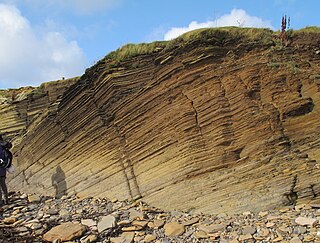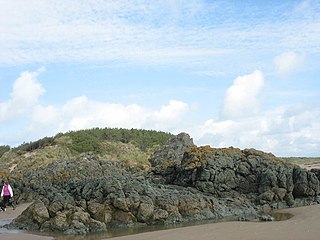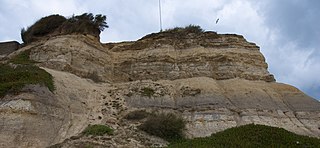 W
WThe Aberystwyth Grits Group is a Silurian lithostratigraphic group in mid Wales. The name is derived from Aberystwyth in northern Ceredigion where the strata are well exposed in coastal cliffs. The Group comprises the Trefechan Formation and the underlying Mynydd Bach Formation. The rocks of the Aberystwyth Grits Group have also previously been known as the Aberystwyth Grits Formation
 W
WThe Ardvreck Group is a stratigraphic group of early Cambrian age found in the Northwest Highlands of Scotland. It lies unconformably on gneisses of the Lewisian complex or sandstones of the Torridonian Supergroup. It consists of two formations, the basal quartzites and quartz arenites of the Eriboll Formation and the overlying dolomitic siltstones and sandstones and quartz arenites of the An-t-Sron Formation. It is overlain conformably by the Ghrudaidh Formation of the Durness Group. The Ardvreck Group was at one time known as the "Eriboll Group".
 W
WThe Aylesbeare Mudstone Group is an early Triassic lithostratigraphic group in southwest England. The name is derived from the village of Aylesbeare in east Devon. The Group comprises the Littleham Mudstone Formation, the Exmouth Mudstone and Sandstone Formation and the underlying Clyst St Lawrence Formation. The strata are exposed on the coast between Exmouth and Budleigh Salterton where the type section is defined. The rocks of the Aylesbeare Mudstone Group have also previously been known as the Aylesbeare Group and the Aylesbeare Mudstone Formation.
 W
WThe Borrowdale Volcanic Group is a group of igneous rock formations named after the Borrowdale area of the Lake District, in England. They are Caradocian in age. It is thought that they represent the remains of a volcanic island arc, approximately similar to the island arcs of the west Pacific today. This developed as oceanic crust to the (present) north-west and was forced by crustal movement under a continental land-mass to the present south-east. Such forcing under, as two plates meet, is termed subduction. This land-mass has been named Avalonia by geologists. It is now incorporated into England and Wales and a sliver of North America.
 W
WThe Bracklesham Group, in geology, is a series of clays and marls, with sandy and lignitic beds, in the middle Eocene of the Hampshire Basin and London Basin of England.
 W
WThe Caithness Flagstone Group is a Devonian lithostratigraphic group in northern Scotland. The name is derived from the traditional county of Caithness where the strata are well exposed, especially in coastal cliffs.
 W
WThe Chalk Group is the lithostratigraphic unit which contains the Upper Cretaceous limestone succession in southern and eastern England. The same or similar rock sequences occur across the wider northwest European chalk 'province'. It is characterised by thick deposits of chalk, a soft porous white limestone, deposited in a marine environment.
 W
WThe Coniston Group is a Silurian lithostratigraphic group in the southern Lake District and north-west Pennines of northern England. The name is derived from the small town of Coniston in Cumbria. The rocks of the Group have also previously been referred to as the Coniston Grits or Coniston Grits Formation and Coniston Subgroup. The group comprises sandstones and siltstones and some laminated hemipelagites which achieve a thickness of between 1400 and 1900m. Overlain by the Bannisdale Formation of the Kendal Group and underlain by the Wray Castle Formation of the Tranearth Group, it is divided into several formations. These are, in ascending order : Wray Castle, Gawthwaite, Latrigg, Poolscar, Moorhow and Yewbank.
 W
WThe Corallian Group or Corallian Limestone is a geologic group in England. It is predominantly a coralliferous sedimentary rock, laid down in the Oxfordian stage of the Jurassic. It is a hard variety of "coral rag". Building stones from this geological structure tend to be irregular in shape. It is often found close to seams of Portland Limestone. It is a younger limestone than its near-neighbour, the Oolitic, as found in the Cotswolds, in Gloucestershire. It is laterally equivalent to and interfingers with units of the Ancholme Group.
 W
WThe Dartmouth Group is an early Devonian lithostratigraphic group from north and east Cornwall to southeast Devon in southwest England. The name is derived from the port of Dartmouth. The Group comprises the Whitsand Bay and Bin Down formations. The type area is along the southeast coast of Cornwall. The sequence has had various earlier names including the Dartmouth Beds or Slates.
 W
WThe Dent Group is a group of Upper Ordovician sedimentary and volcanic rocks in north-west England. It is the lowermost part of the Windermere Supergroup, which was deposited in the foreland basin formed during the collision between Laurentia and Avalonia. It lies unconformably on the Borrowdale Volcanic Group. This unit was previously known as the Coniston Limestone Group or Coniston Limestone Formation and should not be confused with the significantly younger Coniston Group.
 W
WThe Eday Group is a Devonian lithostratigraphic group in Orkney, northern Scotland. The name is derived from the island of Eday where the strata are exposed in coastal cliffs.
 W
WThe Exeter Group is a Permian lithostratigraphic group which occurs through East Devon in southwest England. The name is derived from the city of Exeter in Devon which is partly underlain by rocks of this age.
 W
WThe Exmoor Group is a late Devonian to early Carboniferous lithostratigraphic group in southwest England whose outcrop extends from Croyde in north Devon east across Exmoor to Minehead in west Somerset. The group comprises the following formations the:Pilton Mudstone Formation Baggy Sandstones Formation Upcott Slates Formation Pickwell Down Sandstones Formation Morte Slates Formation Ilfracombe Slates Formation Hangman Sandstone Formation Lynton Formation
 W
WThe Gray Sandstone Group is a late Silurian lithostratigraphic group in west Wales. The strata are exposed in the coast around the Milford Haven area; outcrops occur either side of Marloes Bay. Besides quartzitic sandstones and mudstones, sandy rottenstones are found at outcrop. Fossils within the rottenstone beds include brachiopods and corals. The rocks of this group have also previously been known as the Gray Sandstone Series.
 W
WThe Great Estuarine Group is a sequence of rocks which outcrop around the coast of the West Highlands of Scotland. Laid down in the Hebrides Basin during the middle Jurassic, they are the rough time equivalent of the Inferior and Great Oolite Groups found in southern England.
 W
WThe Gwna Group is a late Precambrian (Ediacaran) / Cambrian lithostratigraphic group in northwest Wales. The name is derived from the Afon Gwna, a river near Bodorgan on Anglesey where the strata are exposed. This rock sequence is also commonly referred to as the Gwna Mélange.
 W
WThe Holsworthy Group is a late Carboniferous lithostratigraphic group in north and east Cornwall and Devon in southwest England. The name is derived from the Devon town of Holsworthy. The Group comprises the Crackington, Bideford and Bude formations. In the Launceston area the group is represented by the Bealsmill Formation. It was formerly known as the Upper Culm Group.
 W
WThe Lambeth Group is a stratigraphic group, a set of geological rock strata in the London and Hampshire Basins of southern England. It comprises a complex of vertically and laterally varying gravels, sands, silts and clays deposited between 56-55 million years before present during the Ypresian age. It is found throughout the London Basin with a thickness between 10m and 30m and the Hampshire Basin with a thickness between 50m and less than 25m. Although this sequence only crops out in these basins, the fact that it underlies 25% of London at a depth of less than 30m means the formation is of engineering interest for tunnelling and foundations.
 W
WThe Lower Greensand Group is a geological unit, part of the quite widely remaining underlying geological structure of southeast England. South of London in the counties of West Sussex, East Sussex, Surrey and Kent, which together form the wider Weald, the Lower Greensand can usually be subdivided to formational levels with varying properties into the Atherfield Clay Formation, the Hythe Formation, the Sandgate Formation, and the Folkestone Formation. North and west of London – including Cambridgeshire, Bedfordshire and Buckinghamshire – it is referred to as the Woburn Sands Formation. In Oxfordshire it is known as the Faringdon Sand. In North Wiltshire as the Calne Sands Formation and in parts of Wiltshire, Oxfordshire and Buckinghamshire as the Seend Ironstone Formation.
 W
WThe Maplewell Group is an Ediacaran lithostratigraphic group present in Leicestershire in the English Midlands. The strata are exposed in Charnwood Forest, west of Leicester. Besides a variety of volcaniclastic sandstones and mudstones, there are various breccias and tuffs. The tuffs which were laid down in water are fossiliferous; Charnia, Charniodiscus and Cyclomedusa, are all recorded from these rocks.
 W
WThe Porth-y-rhaw Group is a Cambrian lithostratigraphic group in west Wales. The name is derived from Menevia, the Roman name for the St Davids area north of St Brides Bay on Pembrokeshire’s west coast where the strata are well exposed in coastal cliffs. This rock succession has previously been known variously as the Menevian Series and Menevian Beds and largely ascribed to the British regional stratigraphic unit St David’s Epoch, though these terms are now obsolete.
 W
WThe Milford Haven Group is a late Silurian to early Devonian lithostratigraphic group in west Wales. The name is derived from the estuary and town of Milford Haven in south Pembrokeshire. The Group comprises calcareous marls with occasional sandstones along with conglomerates and breccias.
 W
WThe Portland Group is a Late Jurassic (Tithonian) lithostratigraphic group in South East England. The name is derived from the Isle of Portland in Dorset where the strata are exposed and have been extensively worked. Rocks of this age have in the past been called the Portlandian stage by geologists, which corresponds with the late Tithonian stage of the internationally used geological timescale.
 W
WThe Ravenscar Group is a Jurassic lithostratigraphic group which occurs within the Cleveland Basin of North Yorkshire and extends to both the Hambleton and Howardian Hills. The name is derived from Ravenscar on the North Yorkshire coast where rocks of this age occur. It was earlier known as the 'Middle Jurassic Series'. It is the stratigraphic equivalent to the Inferior Oolite Group and most of the Great Oolite Group, being overlain by the Cornbrash Formation of the latter unit.
 W
WThe Sherwood Sandstone Group is a Triassic lithostratigraphic group which is widespread in Britain, especially in the English Midlands. The name is derived from Sherwood Forest in Nottinghamshire which is underlain by rocks of this age. It has economic importance as the reservoir of the Morecambe Bay gas field, the second largest gas field in the UK.
 W
WFor the Skiddaw group of hills, see Skiddaw Group
 W
WThe Solva Group is a Cambrian lithostratigraphic group in west Wales. The name is derived from Solva on the west coast of Pembrokeshire where the strata are well exposed in coastal cliffs. This rock succession was formerly known as the Solva Series and ascribed to the British regional stratigraphic unit ‘’St David’s Epoch’’, though these terms are now obsolete.
 W
WThe Teign Valley Group is a late Devonian to late/middle Carboniferous lithostratigraphic group in north Cornwall through Devon and into west Somerset in southwest England. The name is derived from the valley of the River Teign. The Group comprises the Barras Nose, Trambley Cove, Teign Chert and Dowhills Mudstone formations. It also includes the Brendon and St Mellion formations whose stratigraphical context is unclear since all known boundaries of these two unit are tectonic. The Brendon Formation slates extend from Tavistock west to Bodmin Moor. The St Mellion Formation sandstones, siltsones and mudstones are found from Holne northeastwards. The Teign Valley Group was formerly known as the Lower Culm Group or Lower Culm Measures.
 W
WThe Wealden Group, occasionally also referred to as the Wealden Supergroup, is a group in the lithostratigraphy of southern England. The Wealden group consists of paralic to continental (freshwater) facies sedimentary rocks of Berriasian to Aptian age and thus forms part of the English Lower Cretaceous. It is composed of alternating sands and clays. The sandy units were deposited in a flood plain of braided rivers, the clays mostly in a lagoonal coastal plain.
 W
WThe Yesnaby Sandstone Group is a Devonian lithostratigraphic group in west Mainland Orkney, Scotland. The name is derived from the locality of Yesnaby where the strata are exposed in coastal cliffs.